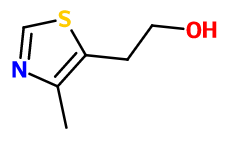
Photo credits: ScenTree SAS
Sulfurol
Thiamine Thiazole ; 4-methyl-5-thiazoleethanol ; 4-methyl-5-thiazolethanol ; 2-(4-methyl-1,3-thiazol-5-yl)ethanol ; Hemineurine ; 5-hydroxyethyl-4-methyl thiazole ; 5-(beta-hydroxyethyl)-4-methyl thiazole ; Methyl thiazolyl ethanol ; Quesote ; Sulfulin

Photo credits: ScenTree SAS
| Company | Ingredient Name | ID | Comments | Naturality | Certifications | Purity | Latin name | Treated part | Geographical origin | MOQ |
|---|---|---|---|---|---|---|---|---|---|---|
|
|
Sulfurol - 30 Gr | - |
Visit website
|
- | - | - | - | - | - | |
|
|
4-METHYL-5-THIAZOLEETHANOL | 2311143210 |
Visit website
|
Synthetic Aroma Chemicals |

|
- | - | - | China | - |
|
|
4-METHYL5THIAZOLEETHANOL (E) | 2311343210 |
Visit website
|
Synthetic Aroma Chemicals |

|
- | - | - | China | - |
|
|
4-METHYL5THIAZOLEETHANOL SUPRA | 2311243210 |
Visit website
|
Synthetic Aroma Chemicals |

|
- | - | - | China | - |
General Presentation
-
CAS N° : 137-00-8
-
EINECS number : 205-272-6
-
FEMA number : 3204
-
FLAVIS number : 15.014
-
JECFA number : 1031
-
Appearance : Colorless liquid
-
Density : 1,196
-
Volatility : Head
-
Price Range : €€
Physico-chemical properties
-
Molecular formula : C6H9NOS
-
Molecular Weight : 143,21 g/mol
-
Log P : Donnée indisponible.
-
Fusion Point : Donnée indisponible.
-
Boiling Point : 280°C
-
Detection Threshold : Donnée indisponible.
-
Optical rotation : Donnée indisponible
-
Vapor pressure : Donnée indisponible
-
Refractive Index @20°C : Donnée indisponible
-
Acid Value : Donnée indisponible.
-
Flash Point : 112°C
Uses
Uses in perfumery :
Sulfurol is used in sandalwood and fruity notes, to sustain a milky and creamy effect, to bring sweetness and for rounding the note.
Year of discovery :
1935
Natural availability :
Sulfurol is present in some grilled meats, in alcoholic beverages (cognac and whiskey among others), in Cocoa Absolut and in peanuts among others, from which it cannot be extracted. Only synthetic Sulfurol is used in perfumery.
Isomerism :
Sulfurol does not have any isomer commonly used in perfumery.
Synthesis precursor :
Sulfurol can be used to synthetise Schiff bases, but those are very rarely synthesized. These bases are made by a reactions between Sulfurol and various aldehydes or ketones.
Synthesis route :
Two ways of synthesis can be used to make Sulfurol. The first one is a reduction of 4-ethyl-5-methylthiazole acetate, by reacting with lithium aluminium hydride, a very strong reductor. Another synthesis route is a condensation reaction between thioformamide and bromoacetopropanol. In this second reaction, both molecules are fusing into a single one, in an acidic medium.
Regulations & IFRA
Allergens :
This ingredient does not contain any allergen.
IFRA 51th :
This ingredient is not restricted for the 51th amendment

